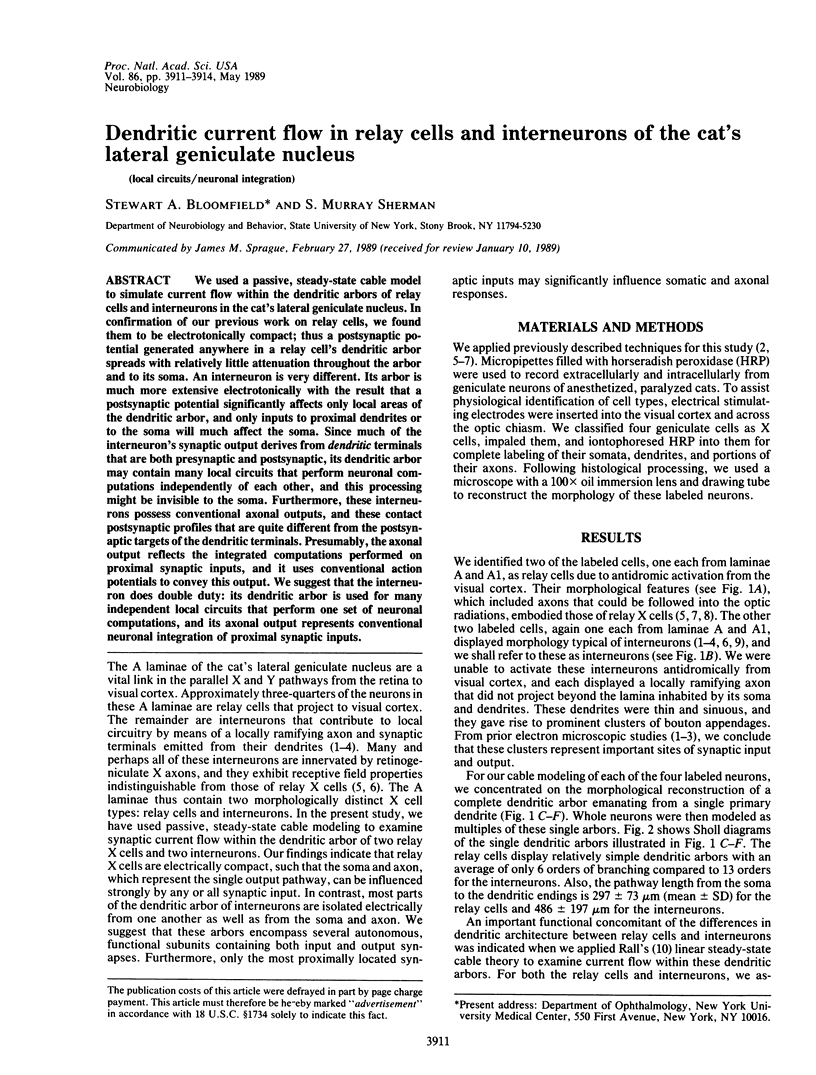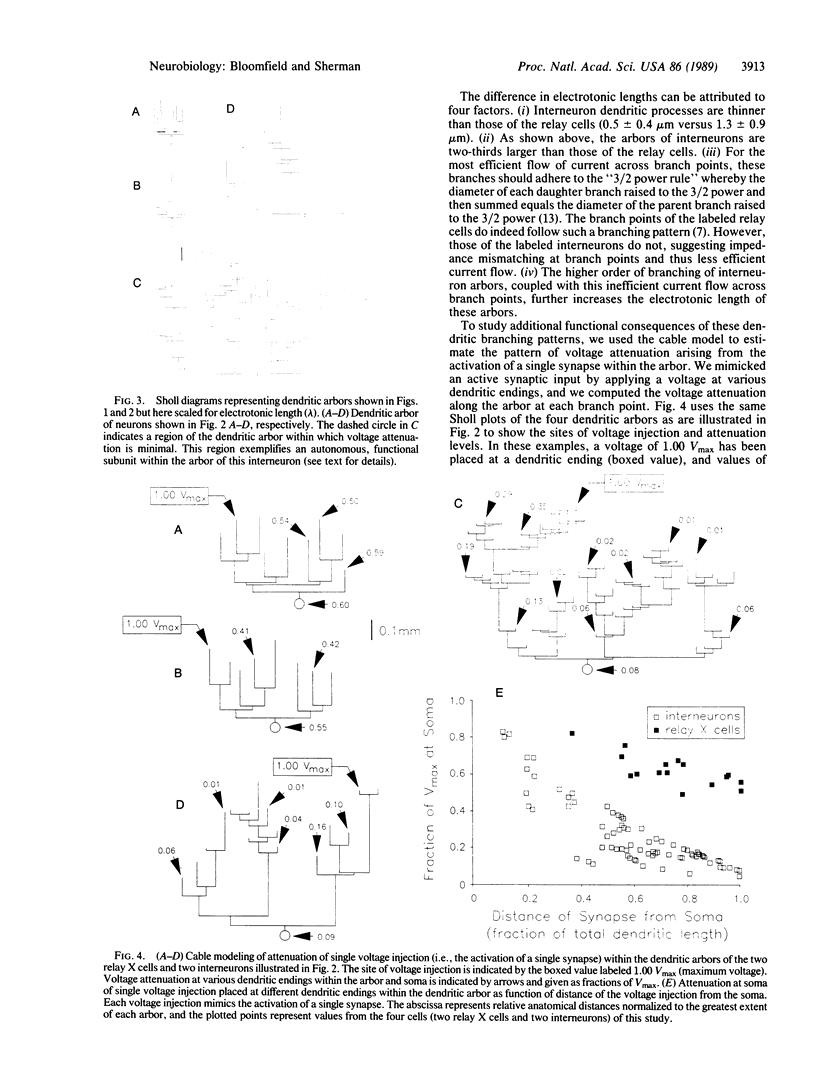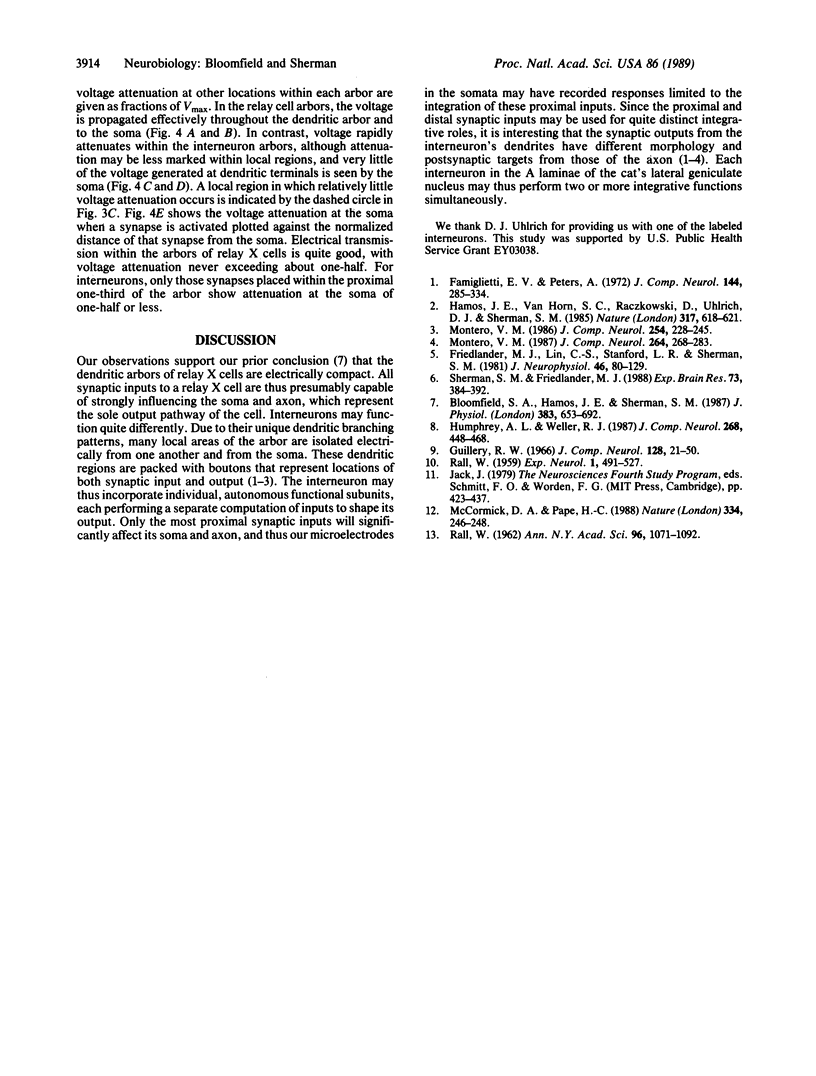Abstract
We used a passive, steady-state cable model to simulate current flow within the dendritic arbors of relay cells and interneurons in the cat's lateral geniculate nucleus. In confirmation of our previous work on relay cells, we found them to be electronically compact; thus a postsynaptic potential generated anywhere in a relay cell's dendritic arbor spreads with relatively little attenuation throughout the arbor and to its soma. An interneuron is very different. Its arbor is much more extensive electronically with the result that a postsynaptic potential significantly affects only local areas of the dendritic arbor, and only inputs to proximal dendrites or to the soma will much affect the soma. Since much of the interneuron's synaptic output derives from dendritic terminals that are both presynaptic and postsynaptic, its dendritic arbor may contain many local circuits that perform neuronal computations independently of each other, and this processing might be invisible to the soma. Furthermore, these interneurons possess conventional axonal outputs, and these contact postsynaptic profiles that are quite different from the postsynaptic targets of the dendritic terminals. Presumably, the axonal output reflects the integrated computations performed on proximal synaptic inputs, and it uses conventional action potentials to convey this output. We suggest that the interneuron does double duty: its dendritic arbor is used for many independent local circuits that perform one set of neuronal computations, and its axonal output represents conventional neuronal integration of proximal synaptic inputs.
Full text
PDF



Selected References
These references are in PubMed. This may not be the complete list of references from this article.
- Bloomfield S. A., Hamos J. E., Sherman S. M. Passive cable properties and morphological correlates of neurones in the lateral geniculate nucleus of the cat. J Physiol. 1987 Feb;383:653–692. doi: 10.1113/jphysiol.1987.sp016435. [DOI] [PMC free article] [PubMed] [Google Scholar]
- Famiglietti E. V., Jr, Peters A. The synaptic glomerulus and the intrinsic neuron in the dorsal lateral geniculate nucleus of the cat. J Comp Neurol. 1972 Mar;144(3):285–334. doi: 10.1002/cne.901440304. [DOI] [PubMed] [Google Scholar]
- Friedlander M. J., Lin C. S., Stanford L. R., Sherman S. M. Morphology of functionally identified neurons in lateral geniculate nucleus of the cat. J Neurophysiol. 1981 Jul;46(1):80–129. doi: 10.1152/jn.1981.46.1.80. [DOI] [PubMed] [Google Scholar]
- Guillery R. W. A study of Golgi preparations from the dorsal lateral geniculate nucleus of the adult cat. J Comp Neurol. 1966 Sep;128(1):21–50. doi: 10.1002/cne.901280104. [DOI] [PubMed] [Google Scholar]
- Hamos J. E., Van Horn S. C., Raczkowski D., Uhlrich D. J., Sherman S. M. Synaptic connectivity of a local circuit neurone in lateral geniculate nucleus of the cat. Nature. 1985 Oct 17;317(6038):618–621. doi: 10.1038/317618a0. [DOI] [PubMed] [Google Scholar]
- Humphrey A. L., Weller R. E. Structural correlates of functionally distinct X-cells in the lateral geniculate nucleus of the cat. J Comp Neurol. 1988 Feb 15;268(3):448–468. doi: 10.1002/cne.902680312. [DOI] [PubMed] [Google Scholar]
- McCormick D. A., Pape H. C. Acetylcholine inhibits identified interneurons in the cat lateral geniculate nucleus. Nature. 1988 Jul 21;334(6179):246–248. doi: 10.1038/334246a0. [DOI] [PubMed] [Google Scholar]
- Montero V. M. Localization of gamma-aminobutyric acid (GABA) in type 3 cells and demonstration of their source to F2 terminals in the cat lateral geniculate nucleus: a Golgi-electron-microscopic GABA-immunocytochemical study. J Comp Neurol. 1986 Dec 8;254(2):228–245. doi: 10.1002/cne.902540207. [DOI] [PubMed] [Google Scholar]
- Montero V. M. Ultrastructural identification of synaptic terminals from the axon of type 3 interneurons in the cat lateral geniculate nucleus. J Comp Neurol. 1987 Oct 8;264(2):268–283. doi: 10.1002/cne.902640210. [DOI] [PubMed] [Google Scholar]
- RALL W. Branching dendritic trees and motoneuron membrane resistivity. Exp Neurol. 1959 Nov;1:491–527. doi: 10.1016/0014-4886(59)90046-9. [DOI] [PubMed] [Google Scholar]
- RALL W. Theory of physiological properties of dendrites. Ann N Y Acad Sci. 1962 Mar 2;96:1071–1092. doi: 10.1111/j.1749-6632.1962.tb54120.x. [DOI] [PubMed] [Google Scholar]
- Sherman S. M., Friedlander M. J. Identification of X versus Y properties for interneurons in the A-laminae of the cat's lateral geniculate nucleus. Exp Brain Res. 1988;73(2):384–392. doi: 10.1007/BF00248231. [DOI] [PubMed] [Google Scholar]


